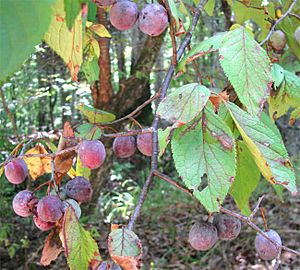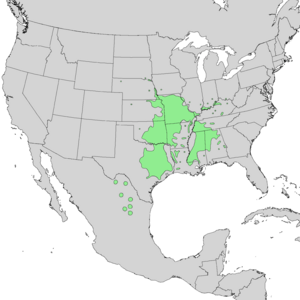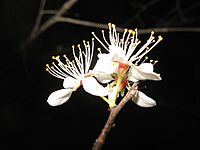Mexican plum facts for kids
Quick facts for kids Mexican plum |
|
|---|---|
 |
|
| Conservation status | |
| Scientific classification | |
| Genus: |
Prunus
|
| Species: |
mexicana
|
 |
|
| Generalized natural range of Prunus mexicana | |
| Synonyms | |
|
|
The Prunus mexicana, also known as the Mexican plum, is a type of plum tree. You can find it growing naturally in the central United States and northern Mexico. Its home range stretches from states like Coahuila and San Luis Potosí in Mexico, all the way north to Wisconsin and South Dakota. It also grows east into states like Georgia, Kentucky, and Ohio. People also grow the Mexican plum in other places, like on the west coast of the United States.
Contents
About the Mexican Plum Tree
Where Does the Mexican Plum Grow?
Mexican plum trees often grow at the edges of forests or in open fields. They are quite tough and can grow in many different types of soil. They can also handle dry weather well, which means they don't need a lot of water once they are established. These trees are known to be hardy in USDA zones 7 to 9, which means they can survive winter temperatures in those areas.
What Does the Mexican Plum Look Like?
This tree usually has a single main trunk. It can grow to be about 15 to 38 feet (4.5 to 11.5 meters) tall. Its leaves are dark green and shaped like an oval.
In early spring, the Mexican plum tree is covered in many white or light pink flowers. These flowers are about an inch wide and smell very nice. The tree's bark is dark grey and has horizontal lines called lenticels.
Its Delicious Fruit
The fruit of the Mexican plum ripens later in the fall. It is usually dark red or purple. Both animals and humans enjoy eating these plums fresh. People also use them to make tasty preserves, like jams or jellies.
How Is It Similar to Other Plums?
The Mexican plum is very similar to another tree called Prunus americana, or the American plum. They look so much alike that sometimes it's hard to tell them apart. In areas where they both grow, especially around Arkansas and Missouri, they can even mix together. This makes it even trickier to identify which specific type of plum tree you are looking at!
Gallery
See also
 In Spanish: Prunus mexicana para niños
In Spanish: Prunus mexicana para niños



